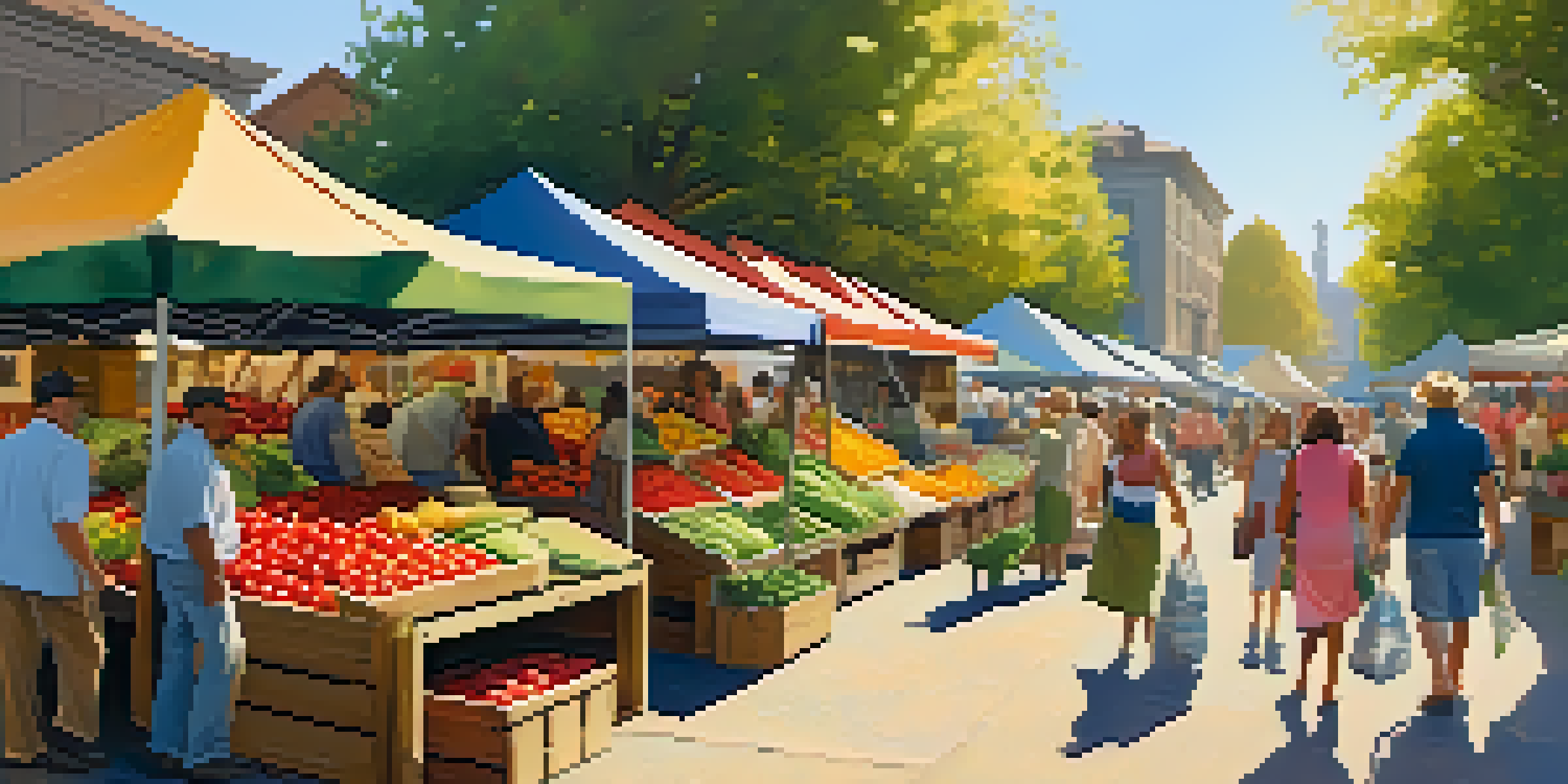Cooking with Local Ingredients: Workshops for Fresh Meals

The Benefits of Cooking with Local Ingredients
Cooking with local ingredients is not just about freshness; it’s about flavor and nutrition. When you source your ingredients from nearby farms, you’re likely to get produce that’s at its peak ripeness, which means more vibrant tastes and essential nutrients. For example, a ripe tomato picked the same day is far superior to one that has been shipped across the country.
Eating locally is not just a diet, it’s a lifestyle that supports your community and the environment.
Moreover, local ingredients support your community’s economy. By purchasing from local farmers and producers, you’re helping to sustain jobs and agricultural practices in your area. This creates a ripple effect, fostering a stronger local food system that benefits everyone.
Lastly, cooking with local ingredients can connect you to the seasons. You’ll be inspired to use what’s available, leading to a deeper appreciation of nature’s cycles. Imagine making a hearty soup in winter with root vegetables harvested just days before; it’s a delicious way to celebrate the season!
Finding Local Workshops Near You
Many communities offer workshops focused on cooking with local ingredients, and finding one is easier than you might think. Start by checking with local farms, community centers, or even culinary schools, which often host events that highlight seasonal produce. Websites like Eventbrite or local food blogs can also be great resources to discover upcoming classes.

Another excellent way to find workshops is to connect with local food enthusiasts through social media or community groups. Often, these platforms feature events that might not be widely advertised, giving you insider access to unique experiences. You might even stumble upon a pop-up cooking event featuring local chefs!
Freshness Boosts Flavor and Nutrition
Cooking with local ingredients enhances the taste and nutritional value of your meals by using produce at its peak ripeness.
Don’t forget to consider virtual workshops as an option. With many culinary classes moving online, you can participate in sessions hosted by chefs from around the world, all while using local ingredients. This flexibility allows you to learn new techniques and recipes from the comfort of your home.
What to Expect in a Local Cooking Workshop
Attending a local cooking workshop can be an exciting and educational experience. Typically, these workshops start with a tour of the local farm or market, where you can see firsthand where your ingredients come from. This connection to the source adds a deeper appreciation for the food you'll be preparing.
The best way to find yourself is to lose yourself in the service of others.
Once you’re in the kitchen, expect a hands-on experience guided by knowledgeable instructors who are passionate about local cuisine. They will often share tips and tricks for selecting the best produce, plus techniques for enhancing flavors through simple cooking methods. This is where you’ll gain a treasure trove of culinary skills that you can take home.
Finally, most workshops culminate in a communal meal, allowing participants to enjoy the dishes they’ve created together. This aspect fosters a sense of community and connection, making the experience memorable beyond just cooking. Sharing stories over a table filled with fresh, local fare is a joy that can’t be replicated.
Incorporating Seasonal Ingredients into Your Meals
One of the most enjoyable parts of cooking with local ingredients is learning how to incorporate seasonal produce into your everyday meals. Seasonal cooking not only enhances the flavors of your dishes but also encourages variety in your diet. For instance, you might find yourself using zucchini in the summer and hearty squash in the fall, each bringing its own unique taste and texture.
To make this easier, consider creating a seasonal meal plan that aligns with what’s available in your area. Many farmers’ markets publish lists of seasonal produce, which can help you strategize your cooking. This approach not only keeps your meals interesting but also reduces your carbon footprint by minimizing transport.
Community Workshops Enhance Skills
Local cooking workshops provide hands-on experiences that deepen your connection to food and teach valuable culinary techniques.
Experimentation is key! Don’t hesitate to try new recipes based on what you find at the market. You might discover that a simple stir-fry with local greens or a salad featuring heirloom tomatoes can quickly become your new favorite dish. Embracing seasonal cooking opens up a world of culinary creativity.
The Role of Community in Local Cooking
Community plays a vital role in the movement towards cooking with local ingredients. Many workshops emphasize collaboration, bringing together individuals who share a passion for sustainable food practices. This sense of togetherness fosters friendships and networks that extend beyond the kitchen.
Moreover, local cooking workshops often highlight cultural traditions that celebrate regional ingredients. Participants can learn about different cooking styles and recipes that have been passed down through generations, enriching their culinary repertoire. It’s a beautiful way to honor cultural heritage while also supporting local agriculture.
By participating in these community events, you become part of a larger movement towards sustainability and healthy eating. Your engagement not only enhances your cooking skills but also contributes to a community that values local food, making every meal more meaningful.
Tips for Sourcing Local Ingredients at Home
Sourcing local ingredients doesn’t have to be confined to workshops; you can bring that experience into your own kitchen! Start by visiting your local farmers' market, which is typically brimming with fresh produce, artisan breads, and homemade jams. Building relationships with local vendors allows you to learn about what’s in season and how to prepare it.
If you can’t make it to a market, consider subscribing to a Community Supported Agriculture (CSA) program. This model connects consumers directly with local farmers, allowing you to receive a box of seasonal produce each week. It’s a great way to discover new vegetables and fruits you may not have tried otherwise.
Sourcing Local Ingredients is Easy
You can find local ingredients through farmers' markets, CSA programs, and even by growing your own herbs at home.
Lastly, don’t overlook your own backyard or community gardens. Growing your own ingredients, even if it’s just a few herbs on your windowsill, can be incredibly rewarding. It’s a fun way to ensure you have fresh, local ingredients right at your fingertips, elevating your cooking to a whole new level.
Creating a Sustainable Cooking Routine
Establishing a sustainable cooking routine can enhance your culinary adventures while benefiting the environment. Start by setting aside time each week to plan your meals based on what’s seasonal and available locally. This not only saves you money but also reduces food waste, as you’ll be using ingredients at their freshest.
Consider batch cooking or meal prepping to maximize your time in the kitchen. Preparing meals in advance allows you to focus on using local ingredients without the rush during a busy week. Plus, it can make weeknight dinners a breeze when you have delicious meals ready to go!

Lastly, involve your family or friends in the process. Cooking together can turn into a fun activity that strengthens relationships while teaching everyone about the importance of local food. Whether it’s a themed cooking night or a simple dinner prep, sharing the experience makes it all the more enjoyable.